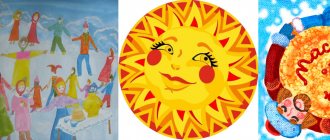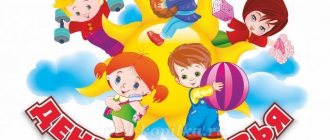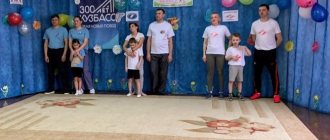Tomorrow, children will have a reason for double joy: firstly, the long-awaited summer will finally come, and secondly, on June 1st, a children's holiday - International Children's Day. And today we invite you to learn the history of this holiday, as well as get acquainted with its features and traditions.
Tomorrow, children will have a reason for double joy: firstly, the long-awaited summer will finally come, and secondly, on June 1st, a children's holiday - International Children's Day . Let us immediately note that this is not only a national holiday, but also a universal one, since it concerns each of us (after all, we were all once children and needed special protection from the cruelty and violence of the adult world).
And today we invite you to learn the history of this holiday, as well as get acquainted with its features and traditions.
History of Children's Day
There are several assumptions and versions of the formation of Children's Day.
Version No. 1
On June 1, 1925, a conference was held in Geneva on the issue of the well-being of children around the world, during which it was decided to celebrate Children's Day.
Version No. 2
Also in 1925, on June 1, the Chinese consul organized a children's party in San Francisco for orphans from his country, in whose honor a national dragon boat festival was held. The international community liked this idea and as a result, International Children's Day .
Version No. 3
In 1945, when the issue of the well-being of children left without parental care as a result of World War II worried many people, a women's congress was held in Paris, the participants of which vowed to fight for world peace for the sake of a bright future for all children and established Children's Day. , the celebration of which was scheduled for June 1. Just 5 years later (in 1950), the first mass (international) celebration of this day took place, which has survived to this day.
In 1959, the Declaration of the Rights of the Child was announced, which had no legal force, but still became the basis of many legislative documents of many states. Then came the Convention on the Rights of the Child (54 articles on the rights of children and the responsibilities of adults), ratified by 1990 by most countries in the world.
It’s interesting that the celebration of Children’s Day has grown into a tradition (and each country has its own tradition), and the holiday itself even has a flag. The symbolism of the flag is expressed in the image of a children's round dance on a green background, in the center of which our Planet is located. Colored people (skin colors of different races) unite the children into one star - a symbol of light.
Scenario of the event "Children's Day" for primary school students
Scenario of the event "Children's Day"
Author:
Victoria Vladislavovna Sattarova, primary school teacher, 1st qualification category, Municipal Budgetary Educational Institution “Secondary School No. 7”, Anapa
Goals:
Formation of ideas about the holiday “Children’s Day”.
Tasks:
— Expand knowledge about the holiday – Children’s Day. — To arouse a desire to take an active part in the holiday, an emotional and positive attitude in children. — Develop friendly relationships between children, attention, creativity,
— To instill in children a sense of kindness, respect for each other, and mutual understanding.
Equipment:
chalk, balloons, projector, recording of songs, costumes for students who take part in the theatrical performance.
Progress of the event
* Children enter the hall to the music: “Let there always be sunshine”
1 presenter:
Hello! Hello! We are happy to greet you! How many bright smiles We see on faces now.
2 presenter:
- Guys, do you know what day it is today? That's right, today is the first day of summer, and this day is also designated on the calendar as International Children's Day!
International Children's Day is celebrated annually on June 1, established in November 1949 in Paris by the decision of the Congress of the International Democratic Federation of Women, and was first celebrated in 1950. Children's Day is a bright, sunny holiday of friendship, a holiday of summer.
3rd presenter:
— The holiday even has its own flag - a green canvas, on which five multi-colored schematic men (red, blue, black, white and yellow) are located around the symbol denoting our planet. All together this symbolizes the unity and diversity of people living on Earth.
1 presenter:
The first of June is Big Ideas Day. Defense Day in the world of Little Children!
2 presenter:
— We present to your attention the song “What color is summer?” performed by 3rd grade students.
3rd presenter:
— Children are full-fledged members of human society. They also have rights and responsibilities. People from different countries came together, agreed and accepted the same rights for everyone, regardless of what country the little person lives in. In 1989, the United Nations created and adopted a document outlining the rights and responsibilities of children. This document is called the Convention on the Rights of the Child.
1 presenter:
Let every child not be offended, Let him become dearer, dearer and closer - Not only today, on the first day of June - On any day of the week, both on holidays and on weekdays. Let childhood not be more terrible than adult life, Let children’s tears be shed less and less, Let a smile in a dream prove: he lies under gentle, but strong, reliable protection.
2 presenter:
* Competition “Who can remember the most”
— I pronounce the title of the fairy tale, and you say what rights of the hero or heroes were violated.
“Kolobok”: (a fox, a wolf, etc. want to take the hero’s life)
“The Wolf and the Lamb” (fable): (the wolf makes an attempt on the life of the lamb)
“The Ugly Duckling”: (the little duckling was offended, the law treats everyone equally, regardless of skin color, appearance or speaking another language)
“Cinderella”: (the unfortunate girl was forbidden to participate in the games and amusements of her sisters, did not have the right to rest and leisure)
«
The Adventures of Pinocchio": (the main character did not take advantage of the right to free education)
“The Wolf and the Seven Little Goats”: (The wolf has no right to invade our home, it is inviolable)
3rd presenter:
— War has no age, gender or nationality. War is terrible. War does not choose. Every year we remember the war that claimed millions of lives. Every year we thank those who fought for our country.
1 presenter:
— From 1941 to 1945, several tens of thousands of minor children took part in hostilities. Village boys and girls, guys from cities - they were posthumously recognized as heroes. Along with adults, they suffered hardships, defended, shot, were captured, sacrificing their own lives. They ran away from home to the front to defend their homeland. They stayed at home and suffered terrible hardships. In the rear and on the front line, they accomplished a small feat every day. They didn't have time for childhood, they didn't get years to grow up. They grew up minute by minute, because war does not have a childish face.
2 presenter:
- Let's remember their names:
Valya Kotik is one of the youngest Heroes of the USSR. In a village occupied by German troops, the boy secretly collected weapons and ammunition and handed them over to the partisans. The guy was mortally wounded in February 1944.
Marat Kazei managed to graduate from the 4th grade of a rural school. He went on reconnaissance missions, took part in raids and undermined echelons.
3rd presenter:
Sasha Kolesnikov and his friend ran away from class and went to the front. Sasha lied that he was left completely alone. So at the age of 12 he became a soldier, “the son of a regiment.” He successfully went on reconnaissance missions several times and helped destroy a train with German ammunition. During his service, Sasha grew to become a tank driver and knocked out several enemy vehicles.
When the war began, Lenya Golikov got a rifle and joined the partisans. Under the guise of a beggar, Lenya walked around the villages, collecting the necessary information about the location of the fascist troops and the amount of their military equipment, and then passed this information on to the partisans. The boy died in a battle with a Nazi punitive detachment.
1 presenter:
Zina Portnova served as a scout for a partisan detachment. In 1943, Portnova was captured by the Germans. During the interrogation, she grabbed the investigator's pistol from the table, shot him and two other fascists, and tried to escape. But she failed to do this.
This collection contains only a few stories of children who died on the front line for their own country; children who committed acts that adults were afraid to think about; children whom the war deprived of their childhood, but not their fortitude.
* Include video clip “About that spring”
https://www.youtube.com/watch?v=UsHpRdZBuVY
2 presenter:
— Traffic rules for children are of great importance for preserving their life and health.
* Theatricalization (author, hedgehog - mother, hedgehog - son, car)
Naughty pedestrian.
A road runs through the forest, the traffic light blinks strictly. Everyone is in a hurry to cross: From moose to mice. Sometimes there are a lot of pedestrians across the road, jumping, walking, flying, running, crawling. Mom taught the hedgehog, Mom threatened with her finger: “Remember the rules, baby!” If the light is red, stop! If it's yellow, just wait, If it's green, go ahead! Naughty pedestrian Did the opposite! The hedgehog was in a hurry and rolled straight into a red light! Is it possible? Of course not! The brakes squealed, and the hedgehog closed his eyes. The old fat dump truck honked and growled: “I barely stopped, I almost fell off the road!” What, you don’t know the rules?! Well, quickly march into the bushes! I'll give you some advice, hedgehog: Don't run the red light! The hedgehog quietly panted: “Sorry, I didn’t mean to.” The traffic light told us: The hedgehog has improved since then. He knows the order best of all, does not violate anything!
3rd presenter:
— The best protection and support are true friends. No wonder they say that a tree lives by its roots, and a person lives by friends.
1 presenter:
— Listen to the parable: Nails
Once upon a time there was a boy with a terrible character. His father gave him a bag of nails and told him to hammer a nail into the garden fence every time he lost his temper and quarreled with someone. On the first day the boy hammered 37 nails. Over the next weeks he tried to hold back, and the number of nails hammered decreased day by day. It turned out that holding back is easier than hammering nails...
Finally the day came when the boy did not hammer a single nail into the fence. Then he went to his father and told about it. And his father told him to pull out one nail from the fence for every day that he did not lose patience.
Days passed after days, and finally the boy was able to tell his father that he had pulled out all the nails from the fence. The father brought his son to the fence and said:
- My son, you behaved well, but look at these holes in the fence. She will never be the same again. When you argue with someone and say things that can hurt, you inflict a wound like this on the other person. You can stick a knife into a person and then pull him out, but the wound will still remain.
No matter how many times you ask for forgiveness, the wound will remain. A mental wound brings as much pain as a physical one. Friends are rare jewels, they bring you smile and joy. They are ready to listen to you when you need it, they support you and open their hearts to you. Try not to hurt them...
2 presenter:
- Our event has come to an end. In parting, we have one wish. We advise you all to be friends. Don't you dare quarrel! Because you can’t live in the world without friends!
*At the end of the event there is a video:
https://www.youtube.com/watch?v=unyX0fBaUPU
3rd presenter:
- And now, guys, I suggest you take the balls and go outside.
— Guys, each of you has a bright ball in your hands. I suggest throwing balloons into the sky and making a wish and shouting a loud cheer.
* Competition: “Drawing on asphalt.
“I suggest you draw your best drawing on the asphalt.”
(each child receives a gift for drawing)
Bibliography
1. https://infourok.ru/material.html?mid=121493
2 https://ped-kopilka.ru/blogs/blog58251/mezhdunarodnyi-den-zaschity-detei.html 3. https://detibdd.ru/scenarii-prazdnikov/
3. https://mshishova.ru/stixi-ko-dnyu-zashhity-detej/
4. https://detibdd.ru/scenarii-prazdnikov/
Objectives and customs of Children's Day
The main objective of the Children's Day is to remind adults of children's rights to education, personal integrity, rest and free time. After all, our future will be adjusted by these children.
Around the world, June 1st goes something like this:
- public organizations visit orphanages where the most vulnerable segments of the population live - abandoned children and orphans;
- children's activities are held in public places and parks;
- television is tuned to children's wavelength.
On this day, adults try to do everything to make children forget about adversity and “charge themselves” with positive emotions. And for this you can use everything that children like so much: sweets, entertainment, gifts, etc.
Children from intact families get the opportunity to spend this day with their parents. Trips to the zoo, cafes and cinema, as well as participation of the whole family in various events organized by city authorities and public organizations. By the way, the competition “drawings on asphalt” is very popular on this day, where you can almost always find a drawing of a children’s holiday : the planet is buried in greenery and 5 colored people hug it.
How Russia celebrates Children's Day
The Children's Fund of Russia has long been the patron of Children's Day. Particular attention is paid to children from low-income and large families. Under the patronage of this foundation and with the active support of local authorities, mass events are being held in all cities of Russia to create a festive mood for both children and their parents.
On the first day of summer, music is heard everywhere, sports competitions, concerts and competitions are organized. The fun continues all day long on a grand scale.
Famous citizens of the country (actors, athletes, government officials) on this day visit children's institutions where orphans are located, since this category of children needs help and, undoubtedly, a festive mood.
On this day, people do not forget about traditional drawings on the asphalt: June 1, traffic is blocked on some streets and the roads literally bloom with bright drawings from childhood. On the gray asphalt, real paintings appear on the most important topic for every person - peace in the family and on the entire planet.
Purpose of celebration
International Children's Day was absolutely necessary at that time. Now this holiday is considered one of the most significant in Russia; not only adults, but also children themselves know about it.
pixabay.com/
The purpose of the holiday is to educate everyone about the problems and difficulties that children encounter in their lives. This day reminds us of how important it is to know and respect the rights of every child.
How to celebrate a children's holiday within the family?
On this day, the task of every parent is to pay maximum attention to their child. Even if the work week is in full swing, you can devote the whole evening to him - the most important person in the life of every parent. If you managed to take a day off from work or the holiday fell on a day off, then try to organize events that your child will truly enjoy: trips, excursions, hikes, exhibitions, etc.
And we also need to remember that there are children deprived of parental love, affection and care. A gift for an orphan living in a nearby orphanage will not only give him at least a few minutes of happiness and faith in human kindness, but will also fill your child’s heart with a feeling of compassion and mercy.
What overshadows Children's Day
Despite the fact that for decades now many public organizations and authorities in most countries of the world have been actively fighting against violence against children (and this, for a minute, is 1/4 of the entire population of the planet), we are talking about an unconditionally happy childhood for every child we can only dream. And in many ways, an absolute cloudless childhood all over the world is hampered by our actions, technological progress and the economic troubles of some countries. For example:
- In countries with developed civilization, the negative influence of television is obvious, which has a detrimental effect on the child’s perception of reality. Experts have long been concerned that many programs, films and even children's cartoons zombify children's minds.
- The harmful influence of computer technology (mainly aggressive games) results in the angry behavior of children. By destroying the child's psyche, games contribute to violence on the street.
- Active promotion of sexual relations, the presence of erotic elements in advertising and the reluctance of parents to talk with children about the negative impact of sex at an early age have led to an increase in the desire for early sexual activity among adolescents.
- Difficult living conditions and unfavorable economic situations in Asian and African countries have caused high levels of childhood morbidity and hunger among the local population.
- Military conflicts still deprive the younger generation of a full life and the opportunity to study normally, since for children in the combat zone, the issue of survival remains in the first place.
And these are just those global children's problems that everyone knows about. But there are still local problems that children face in each individual family. And the list of these problems can be endless.
Subscribe to our Telegram to stay up to date with important news in the field of education.
Flag
This is one of the few holidays that has its own flag. The green canvas depicts a planet on which stand five children of red, blue, white, black and yellow. They all reach out to each other: this symbolizes unity, despite the fact that all people are different.
pixabay.com/




